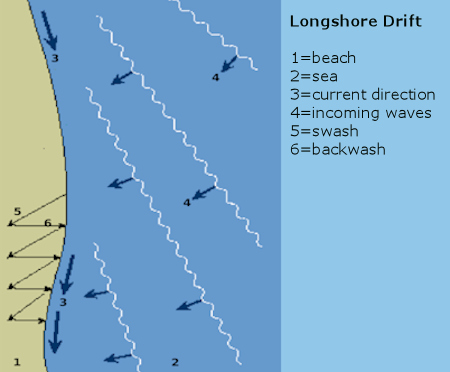Longshore Drift
Longshore drift is a geographical process that consists of the transportation of sediments (clay, silt, sand and shingle) along a coast at an angle to the shoreline, which is dependent on prevailing wind direction, swash and backwash. This process occurs in that part of the sea that is close to the shore, which extends from the high water mark to the shoreline areas that are permanently submerged. The process is also known as littoral drift, longshore current or longshore transport.
Longshore drift causes spits to build up at the mouth of rivers, as happened 2,000 years ago when shingle banks formed off the then south east Kent coast, or at the end of a point of land, as happens and continues to happen at Dungeness.
Longshore drift is influenced by numerous aspects of the coastal system, with processes that occur within the surf zone largely influencing the deposition and erosion of sediments. Longshore currents can generate oblique breaking waves which result in longshore transport.
Longshore drift can generally be defined in terms of the systems within the surf zone as shown in the diagram on the right. This diagram shows that sediment transport along the shore and surf zone is influenced by the swash (occurs in the direction of prevailing wind), which moves the pebble up the beach at the angle of the waves, and moves the pebble back down the beach due to the influence of gravity.
Longshore drift affects numerous sediment sizes as it works in slightly different ways depending on the sediment (e.g. the difference in long shore drift of sediments from a sandy beach to that of sediments from a shingle beach). Sand is largely affected by the oscillatory force of breaking waves, the motion of sediment due to the impact of breaking waves and bed shear from long shore current. Because shingle beaches are much steeper than sandy ones, plunging breakers are more likely to form, causing the majority of long shore transport to occur in the swash zone, due to a lack of an extended surf zone
Video Explaining Longshore Drift

Diagram showing Longshore Drift


















